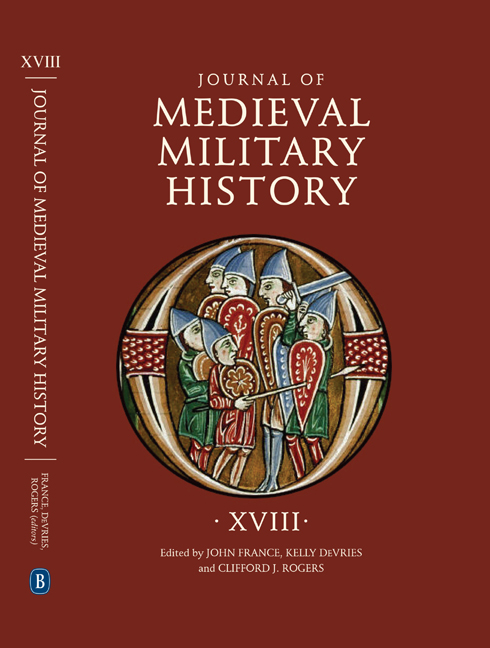Book contents
- Frontmatter
- Contents
- List of Illustrations
- 1 The Eastern Campaigns of King Henry II of Germany, 1003–17
- 2 Peace, Popular Empowerment and the First Crusade
- 3 The Transformation of Naval Warfare in Scandinavia during the Twelfth Century
- 4 Auxiliary Peoples and Military Reform on Hungary’s Western Frontier in the Thirteenth Century
- 5 What Types of Sources Did Medieval Chroniclers Use to Narrate Battles? (England and France, Twelfth to Fifteenth Centuries)
- 6 Experimental Tests of Arrows against Mail and Padding
- 7 Four Misunderstood Gunpowder Recipes of the Fourteenth Century
- 8 The Earliest Middle English Recipes for Gunpowder
- 9 Horses and Horsemen in Fifteenth-Century Siege Warfare, with Particular Reference to the Later Hundred Years War
- 10 Supplying the Army: The Siege of Pisa, 1499
- List of Contributors
- Journal of Medieval Military History 1477–545X
9 - Horses and Horsemen in Fifteenth-Century Siege Warfare, with Particular Reference to the Later Hundred Years War
Published online by Cambridge University Press: 06 October 2020
- Frontmatter
- Contents
- List of Illustrations
- 1 The Eastern Campaigns of King Henry II of Germany, 1003–17
- 2 Peace, Popular Empowerment and the First Crusade
- 3 The Transformation of Naval Warfare in Scandinavia during the Twelfth Century
- 4 Auxiliary Peoples and Military Reform on Hungary’s Western Frontier in the Thirteenth Century
- 5 What Types of Sources Did Medieval Chroniclers Use to Narrate Battles? (England and France, Twelfth to Fifteenth Centuries)
- 6 Experimental Tests of Arrows against Mail and Padding
- 7 Four Misunderstood Gunpowder Recipes of the Fourteenth Century
- 8 The Earliest Middle English Recipes for Gunpowder
- 9 Horses and Horsemen in Fifteenth-Century Siege Warfare, with Particular Reference to the Later Hundred Years War
- 10 Supplying the Army: The Siege of Pisa, 1499
- List of Contributors
- Journal of Medieval Military History 1477–545X
Summary
It is widely accepted that siege warfare formed a significant part of medieval conflict, and one in which cavalry played only a minor role. This article argues that horsemen were in fact essential to the prosecution of a successful siege, and crucial for an effective defense. Cavalry could prevent an army from setting up a siege but also ward against that threat. Once a siege began the horsemen of both sides contested the struggle for supply, both in the vicinity of the siege, and also on its periphery. Cavalry was the most dangerous arm for a sally, but also the key to a successful response, and a vital component of a relieving force. Cavalry dominated the numerous skirmish actions that took place around a siege and was also the arm of pursuit, an army retreating from a failed investment being highly vulnerable to horsemen. Horses drove mills, carried provisions, pulled the artillery, and were present at sieges in considerable numbers, making them instrumental in the spread of disease due to the large amounts of waste they produced. However, their role in the transmission of bacillary dysentery, the great scourge of medieval siege warfare, was probably other than by water-borne infection. War horses were valuable animals and siege warfare offered opportunities for their capture, while its privations caused the animals great distress, not least because they required considerable maintenance. In good condition horses contended with the enemy and secured supplies but, if provisions failed, their excessive needs rapidly made them weak and ineffective, with drastic consequences both for themselves and their human counterparts. An analysis of several sieges during the later Hundred Years War examines these issues and considers whether the English were compromised by the number and quality of their mounted men-at-arms.
Horses were an essential but vulnerable component of a late medieval army, requiring a complex balanced diet and considerable maintenance. Some historians consider that mounted combat “had, at best, a minor role to play in siege warfare,” and question why “large numbers of expensive, highly trained, but very fragile war horses” were brought to sieges when they had to be “watered, fed and guarded while waiting for the unlikely chance that they might be used.”
- Type
- Chapter
- Information
- Journal of Medieval Military HistoryVolume XVIII, pp. 193 - 244Publisher: Boydell & BrewerPrint publication year: 2020



